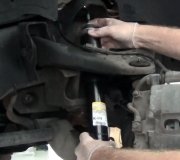Have the vehicle plugged into a diagnostic computer to locate the cause of the fault
Following an increase in vehicle loading, the dampers adapt to maintain the height of the vehicle within its design range. The system uses road inputs to the suspension to power the levelling action, and requires up to approximately two kilometers of travel, following a change in load, to complete the process.
Normal movement of the suspension causes a pumping action to occur within the damper, as a result of extension and compression of the pump rod in the pump chamber. Hydraulic fluid is pumped from the pump chamber into a high pressure gas accumulator. The increase in gas pressure augments the force developed between the vehicle axle and the body, thereby providing lift.
A control orifice in the pump rod determines the levelling height. When the damper is compressed, this orifice is covered. When the damper extends, the control orifice is uncovered, pressure is released to the low pressure oil reservoir and the system ceases to rise. When the vehicle is high after unloading, the opened control orifice allows fluid to be returned to the low pressure oil reservoir, and the suspension returns to its normal unladen height.
Adaptive Damping
Adaptive damping enhances vehicle handling by the use of special dampers which are controlled by a dedicated control module.
Adaptive damping may be specified as an option on certain models. Adaptive damping and ride levelling are mutually exclusive options. The adaptive damping system is completely automatic, requiring no input from the driver.
Adaptive Dampers
The adaptive dampers:
Are installed in place of the normal dampers.
Can be identified by the cable and connector at the top of the unit.
Have two settings; firm and soft.
Require no adjustment and are non-serviceable items.
Accelerometers
The three accelerometers:
Sense vehicle body movement.
Generate an analogue voltage (maximum +5 volts) proportional to body movement.
Provide inputs to the adaptive damping control module.
The two vertical accelerometers are mounted on the bulkhead and in the trunk.
The lateral accelerometer is mounted in the ECM housing.
The ADCM:
Is mounted on the fascia support bracket.
Controls the four adaptive dampers in response to analogue and digital inputs.
Is hard-wired to the instrument cluster message center.
Is hard-wired to the J1962 diagnostic connector.
Operation
The system selects the soft or firm damper setting according to the current road and driving conditions, to optimize vehicle ride and handling.
With the vehicle stationary, the dampers are in the firm setting, but will normally switch to the soft setting when the vehicle exceeds 8 km/h (5 mile/h); all dampers are switched simultaneously.
Sudden movement of the vehicle body, in response to road inputs, is detected by the vertical accelerometers, and the ADCM switches the dampers to the firm setting to give improved damping of the resultant oscillations.
When cornering forces are detected by the lateral accelerometer, the ADCM switches the dampers to the firm setting to reduce the roll rate and improve wheel control.
After the event has passed, the dampers revert to the soft setting.
When the footbrake is applied, the ADCM receives a signal and calculates the rate of vehicle deceleration. If the deceleration rate is greater than a certain threshold, the dampers are switched to the firm setting to reduce the pitch rate and improve wheel control.
If a system failure occurs, the ADCM grounds the output line to the instrument cluster message center, which displays a text warning SUSPENSION FAULT and illuminates the amber warning lamp. Under fault conditions the system always fails to the firm setting, so that the vehicle will be safe to drive under all road and driving conditions.
Monday, April 26th, 2010 AT 5:00 AM


